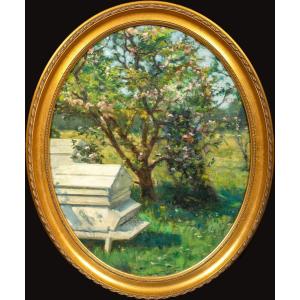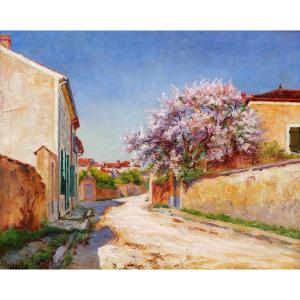His father, the theater decorator Charles Laloue, married Marie Eudoxie Lambert in Paris at Batignolles on December 29, 1853. Eugène Gallien-Laloue was born on December 11 of the following year in Montmartre, on Rue Léonie. He was baptized the following January in the parish of Saint-Pierre de Montmartre.
He was a student of Léon Germain Pelouse (1838–1891), a painter from the Barbizon School, whose influence he experienced, but without being a direct member of that group.
After his father's death in 1870, Eugène had to leave school and find work, being the eldest of nine boys. His mother placed him with a notary. By lying about his age, he enlisted to fight in the Franco-Prussian War of 1870. In 1874, he lived on Rue de Clignancourt and was recruited by the Société Française des Chemins de fer (French Railway Company) to draw the railway routes from Paris to provincial train stations. He took advantage of this work to paint the surrounding landscapes and later the districts of Paris, producing a significant number of gouaches while carefully respecting the perspective of buildings. He varied the tone of the sky, the appearance of trees, and lighting according to the seasons, often animating scenes with people, particularly enjoying the effects of wet sidewalks in the rain or snow. His work is also closely tied to the landscapes of small villages in the Île-de-France region. In 1874, he stayed in Fontainebleau where he painted sunsets and sunrises, as well as scenes of farmyards and courtyards in Samois-sur-Seine, in the company of Charles Jacque and Léon Dupuy, an artist who would not have a successful career but whose name Eugène Galien-Laloue would later adopt as a pseudonym, giving it new life and recognition in artistic circles. On Montmartre Hill, he painted La Foire de Montmartre (The Montmartre Fair), Place Pigalle, and the construction site of the Sacré-Cœur. He used numerous pseudonyms, the most common being L Dupuy, Kerminguy, Lenoir, Galieny, and Lievin.
In 1879, he married Flore Bardin (1861–1887), who gave birth to a son, Fernand, on July 3, 1880. In 1892, he married for the second time to Ernestine Bardin, his first wife's sister, who gave birth to a daughter, Flore Marie Agnès, on February 4, 1893. That same year, he worked at the Bateau-Lavoir, but his solitary nature did not suit that environment. When World War I was declared, he was not drafted due to his voluntary enlistment in 1870 and his age, but he created numerous drawings and watercolors depicting military scenes in 1914. His daughter left the family home after her marriage in 1919. Ernestine Bardin died in 1925. He then married Claire Bardin, the third sister of his previous wives, in 1930. Widowed again in 1933, he moved into his daughter Flore’s home in 1935. In 1940, he left for exile in Bordeaux, unable to paint due to a broken arm.
He painted landscapes in Normandy, Seine-et-Marne, Marseille, Italy, and Venice. The artistic output of this painter, under his name or pseudonyms, was vast, and his commercial success attracted imitators, with forgeries being common in the art market.
He had two studios in Montmartre: one at 4 Rue Ravignan in 1877, and the second at 24 Rue Houdon, where he worked in 1886. In 1906, he settled in Fontainebleau.
Eugène Galien-Laloue’s grave in Chérence Cemetery
He died on April 18, 1941, at his daughter’s country house in Chérence (Val-d'Oise) and was buried in the local cemetery.
Salons
(This section does not cite its sources sufficiently, February 2016.)
Salon des Artistes Français:
1877: Two paintings, including In Normandy, and two gouaches.
1878: Two paintings.
1879: Two paintings.
1887: The Banks of the Loing, gouache.
1889: Bernay; Banks of the Meuse, gouaches.
1904: Boulevard de Bonne-Nouvelle.
1905: Saint-Denis Gate.
1906: Place Pigalle.
1907: Boulevard Magenta; Saint-Médard Church.
1908: Boulevard de la Madeleine; Boulevard Bonne-Nouvelle.
1909: Place de la Bastille; Saint-Martin Gate.
1911: Quai de l'Hôtel de Ville.
1914: Flower Market at Madeleine.
Exhibitions
1876: Museum of Fine Arts in Reims (Quai aux Fleurs, under the snow).
1882: Exhibition in Reims.
1907: Saint-Quentin and Angers.
1908: Angers and Toulon.
1909: Angers, Saint-Quentin, Le Havre, and Le Mans.
1910: Paris Moderne exhibition (Châtelet Theatre; Quai aux Fleurs).
1911: Angers and Roubaix.
1912: Angers, Bordeaux, Orléans, Saint-Quentin, Versailles, Roubaix, and Saint-Étienne.
1913: Monte-Carlo, Hautecœur, Nogent-sur-Marne, Geneva, and Orléans.
1914: Versailles, Le Puy, Saint-Quentin, and Dijon.
Works in Public Collections
United States:
Huntington (West Virginia), Huntington Museum of Art.
France:
Paris, Musée Carnavalet: Saint-Augustin Church under the snow.
Auvers-sur-Oise, Daubigny Museum.
La Rochelle, Museum of Fine Arts.
Louviers, Louviers Museum.
Mulhouse, Museum of Fine Arts.
Reims, Museum of Fine Arts










































 Le Magazine de PROANTIC
Le Magazine de PROANTIC TRÉSORS Magazine
TRÉSORS Magazine Rivista Artiquariato
Rivista Artiquariato